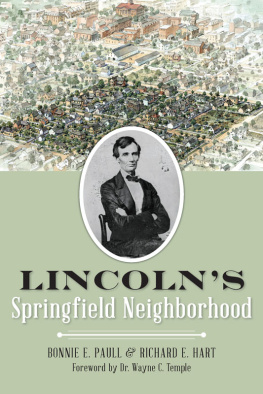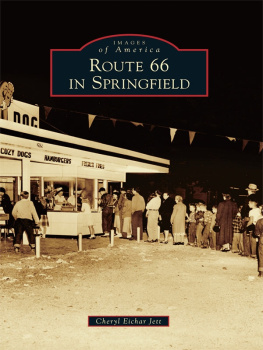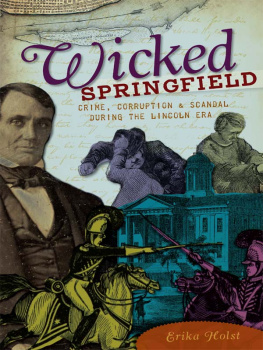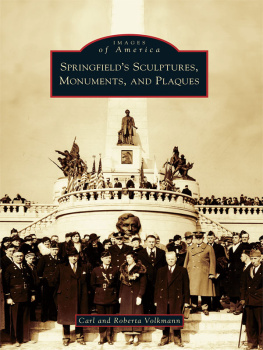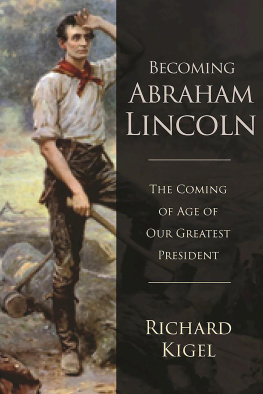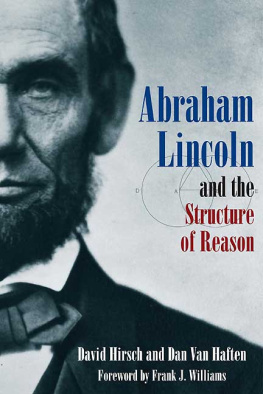


NEIGHBORHOOD MAP LEGEND
Dr. Samuel Melvin and family. The Melvins had five boys who were friends of the Lincoln boys, and they had a daughter they named Mary Lincoln Melvin.
Henry Remann Sr. and Mary Remann were good friends of the Lincolns. Henry Remann Jr. was a best friend of Willie Lincoln. Josie eventually married one of Marys nephews, thus becoming a relative. Mary Remanns sister-in-law, Elizabeth Black, stayed with the family for a year.
Jesse Kent and family lived where the Conference Center now stands. His son Joseph and his brothers helped the Lincolns and played with Willie and Tad.
George and Eliza Wood and family built the first home here. He was a tailor on the square. Amos Worthen, state geologist, occupied the home at the time of Lincolns election.
James Gourley was a shoemaker who often came to help Mary when she was frightened and alone at home.
The Arnold House originally belonged to Reverend Francis Springer and family. His English and Classical School was the first school in the neighborhood.
Jameson Jenkins, drayman and Underground Railroad conductor, bought this property from his brother-in-law, James Blanks. Their mother-in-law, Auntie Jane Pellum, lived in this house or in one at the back of the property.
James Blanks, the brother-in-law of Jameson Jenkins, owned this lot but did not build on it.
The George Shutt House was the property of Mason Brayman, who lived there after renting from the Lincolns when they were in Washington, D.C., in 1848.
Thomas Lushbaugh built a home on this lot. When he moved to Mt. Pulaski, he rented the home, eventually selling it to William Burch. Some of his renters were Reverend Noyes W. Miner, Hannah and John Shearer and Abner Wilkinson.
Ira Brown rented this property to the Wheelocks. Adelia Delie often helped with the boys.
Grace Evangelical Lutheran Church was originally founded by Reverend Francis Springer. During Lincolns time, his brother-in-law, Dr. William Wallace, lived here with his wife, Frances, Mary Lincolns sister.
Stephen Smith and family rented here. Dudley, their infant son, was a favorite of Lincolns. C.M. Smith, his brother, was married to Marys sister Ann.
Charles and Harriet Dallman lived here. Mary helped nurse their newborn child.
The Central Academy, the neighborhoods second school, operated at this site between 1853 and 1858.
John McClernand was a politician and Civil War general. Although opponents politically, Lincoln and he were good friends.

This map is based on the one designed by the Lincoln Home National Historic Site to orient visitors to the area. It designates owners and/or renters of the historic structures and lots in 1860, when Lincoln became president and just before the family departed for Washington, D.C. We have expanded the map to include others who figure prominently in this book and who lived in some of the houses or on the periphery of the immediate neighborhood during the Lincolns seventeen-year tenure there. The map is not definitive in that it does not include every neighbor or servant mentioned in the book as living in the vicinity of the Lincoln Home during this time. The Lincoln neighbors reflect the diversity of Springfield at this time. The Carrigans were Irish immigrants; the Buggs and Dallmans, English immigrants. Henry Remann and his sister Julia Sprigg were German immigrants, and Jameson Jenkins, James Blanks, David King and John Jackson and their families were African Americans. We hope that this will make it easier for you, the reader, to relate the rather extensive cast of characters to the geography of the neighborhood. The shaded forms of buildings indicate where original historic structures or ones built by the Park Service still stand.
Published by The History Press
Charleston, SC 29403
www.historypress.net
Copyright 2015 by Bonnie E. Paull and Richard E. Hart
All rights reserved
Front cover: Richard Schlechts historically researched modern renderings of the Lincoln neighborhood in 1860. Courtesy of the National Park Service; An ambrotype (photograph) of Abraham Lincoln taken on August 13, 1860, by Preston Butler of Springfield, Illinois.
Courtesy of the Abraham Lincoln Presidential Library & Museum.
Frontispiece: Map and Legend of the Lincoln Home Neighborhood. Courtesy of the National Park Service and graphic designer Katrina Crocker.
First published 2015
e-book edition 2015
ISBN 978.1.62585.532.9
Library of Congress Control Number: 2014956341
print edition ISBN 978.1.62619.951.4
Notice: The information in this book is true and complete to the best of our knowledge. It is offered without guarantee on the part of the authors or The History Press. The authors and The History Press disclaim all liability in connection with the use of this book.
All rights reserved. No part of this book may be reproduced or transmitted in any form whatsoever without prior written permission from the publisher except in the case of brief quotations embodied in critical articles and reviews.
To the generationsour parents, our children and our grandchildrenWill, Mimi, Wes, R.E., Sena and Osselyn and Hayden.
In a frontier community folks have to cooperate.
In every neighborhood, in every city of the world now,
we have to learn how to cooperate again.
Pete Seeger
In His Own Words
CONTENTS
FOREWORD
Mr. Lincolns Springfield neighborhood probably influenced him more than he influenced the neighborhood. As Richard E. Hart has shown through years of research, this area contained a mix of numerous ethnic groups. He has listed them with their places of nativity. In addition, he has compiled special inventories for those large segments of the population from Ireland and Germany, as well as those of African American descent.
Some young Irish girls worked for the Lincolns as housemaids. Others labored in the homes of the affluent or moderately affluent, which included the Lincolns. Those who were wealthier often had two or more maids living with them. A scattering of black families lived in proximity to the Lincolns. Some did chores for them, and one even cut Lincolns hair. Certainly, the future president saw what motivated those working poor who sought advancement in life with more pay because, as a youth, he had experienced some of their lot. Thus, he could sympathize with the struggling Irish, Germans and African Americans when he became a lawmaker in Washington.
This type of study has never before been done in such a wide scope. Previously, only those families living in the four-square-block area of the Lincoln Home National Historic Site in the 1850s have been examined by such scholars as Edwin C. Bearss of the National Park Service. Paull and Hart successfully expand their study beyond four blocks and cover a longer period of time.
The authors go back to the founding of Springfield and not just to the years when Abraham Lincoln became a noted lawyer among its citizens. Then they travel forward in time to tell, in some detail, the story of the Lincoln family and their place in the neighborhood. Those with special Lincoln connections receive brief biographies. This information makes for very interesting reading and should prove valuable to anyone visiting the Lincoln Home National Historic Site, planning a future visit or just seeking to know more about the Lincolns, their friends, their neighbors and Springfield before they left for Washington.
Next page
